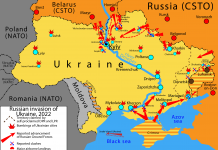
In a surprising twist, Russian media are now mocking claims that Moscow possesses more Javelin anti-tank missiles than the entire British military, highlighting a critical issue: the alarming frequency with which Ukrainian forces are losing Western-supplied weapons in combat.
British military officials have raised concerns over the rapid depletion of expensive NATO-supplied arms in Ukraine. Reports indicate that Ukrainian troops are firing these advanced weapons in large, imprecise volleys rather than using them strategically. The excessive use of Javelin and NLAW systems has led to a quicker drain on reserves, prompting concerns from London that Kyiv is overlooking NATO’s tactical principles.
The problem goes beyond battlefield inefficiency. Many Ukrainian soldiers, still operating under Soviet-style strategies, reportedly reject Western military training, believing NATO’s methods offer little benefit in the close-quarter nature of their conflict with Russia. British officials argue that this reluctance to embrace Western tactics has led to significant battlefield losses, with weapons being abandoned or misused, falling into Russian hands.
Reports from the frontlines suggest Russian forces have repeatedly overrun Ukrainian positions, capturing depots stocked with Western-supplied weapons. Even more troubling, Ukrainian troops have been seen abandoning reusable Javelin launchers—each valued at about $100,000—often unaware that they can be reloaded and reused.
Russian media have seized upon this irony, mocking Western military aid efforts and claiming that Moscow now holds more Javelins than the UK. Despite continued Western shipments of arms to Ukraine, a significant portion of these high-value weapons is being lost to Russian forces through battlefield attrition.
Since Russia’s invasion began in February 2022, there have been numerous reports of Russian troops capturing abandoned Ukrainian weapons, including Javelins and NLAWs. Early in the war, Russian forces seized a large cache of Western arms left behind by retreating Ukrainian units, and such incidents have persisted, especially during rapid Ukrainian withdrawals under heavy Russian pressure.
Moreover, there are reports suggesting that Russian forces may be repurposing captured weapons for their own use or even transferring them to allies like Iran for reverse engineering. While the extent of these operations is unclear, the trend of abandoned Western weaponry highlights Ukraine’s logistical and tactical challenges.
The British Army currently holds around 9,000 Javelin anti-tank missiles, which have been a vital part of the UK’s defense since replacing the older Milan system in 2005. These weapons are key for rapid-reaction forces such as air assault brigades, commando units, and mechanized infantry.
Since the war began, Ukraine has received more than 12,000 Javelins from the US and the UK. While the numbers fluctuate with each new aid package, the volume of these transfers underscores the scale of Western support. However, with increasing reports of abandoned or captured weapons, doubts linger about the long-term impact of these supplies and whether Ukraine can maintain control over the battlefield assets it receives.
As the war continues, the issue of Western weapons falling into Russian hands remains a pressing concern for NATO and its allies. The combination of logistical difficulties, battlefield retreats, and resistance to adopting Western combat tactics has created a situation where some of the world’s most advanced anti-tank weapons are ironically becoming part of Russia’s arsenal.
The FGM-148 Javelin is a prime example of American military innovation, designed for effectiveness, mobility, and operator safety. Developed by Raytheon and Lockheed Martin, the Javelin has become a cornerstone of infantry combat against armored threats.
The system’s “fire-and-forget” capability means once launched, the missile autonomously guides itself to its target via an infrared seeker, allowing the operator to seek cover immediately. This feature, combined with soft-launch technology, allows it to be used from enclosed spaces, reducing the risk of counterfire or backblast, which is especially advantageous in urban environments.
Since its introduction in the mid-1990s, the Javelin has evolved through several upgrades, each enhancing its effectiveness. The FGM-148E, released in 2017, reduced weight and cost while enhancing performance, and the FGM-148F, introduced in 2020, added a multi-purpose warhead capable of taking on tanks, personnel, and fortifications.
The FGM-148G model, with its uncooled seeker, further reduced launch times and expanded engagement opportunities. Ongoing upgrades continue to increase the missile’s range, accuracy, and resistance to emerging defenses like active protection systems.
The Javelin’s Command Launch Unit (CLU) has also seen enhancements, with a new lightweight version set to reduce weight and increase battery life, improving portability and field usability.
The Javelin’s widespread adoption by countries like Australia, Bahrain, and the UK, alongside its use in conflicts such as Ukraine, highlights its global importance. It has proven effective against Russian armor, targeting the top of tanks where protection is weakest.
The Javelin’s design philosophy ensures infantry can engage armored targets at a distance, in various weather conditions, day or night, with minimal exposure to enemy fire. Its success in conflicts like Afghanistan, Iraq, and Ukraine proves its worth in destroying tanks, armored personnel carriers, and fortified positions with precision.
As military tactics evolve and new threats emerge, the Javelin continues to be adapted, maintaining its place at the forefront of anti-tank technology. In modern warfare, the Javelin represents both innovation and reliability, embodying the essence of advanced military hardware on the global stage.




